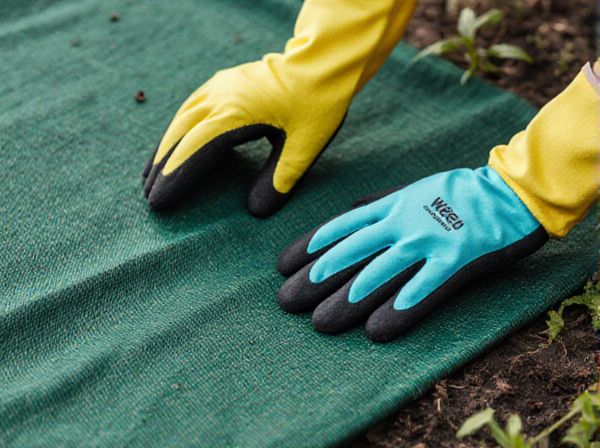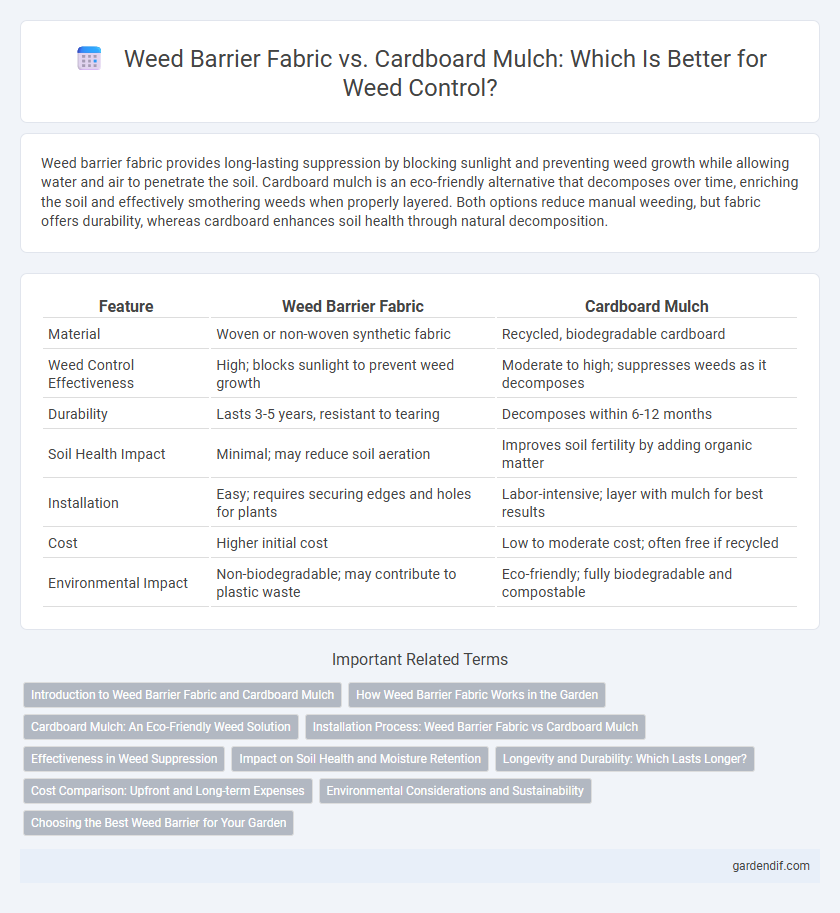
Weed barrier fabric vs Cardboard mulch Illustration
Weed barrier fabric provides long-lasting suppression by blocking sunlight and preventing weed growth while allowing water and air to penetrate the soil. Cardboard mulch is an eco-friendly alternative that decomposes over time, enriching the soil and effectively smothering weeds when properly layered. Both options reduce manual weeding, but fabric offers durability, whereas cardboard enhances soil health through natural decomposition.
Table of Comparison
| Feature | Weed Barrier Fabric | Cardboard Mulch |
|---|---|---|
| Material | Woven or non-woven synthetic fabric | Recycled, biodegradable cardboard |
| Weed Control Effectiveness | High; blocks sunlight to prevent weed growth | Moderate to high; suppresses weeds as it decomposes |
| Durability | Lasts 3-5 years, resistant to tearing | Decomposes within 6-12 months |
| Soil Health Impact | Minimal; may reduce soil aeration | Improves soil fertility by adding organic matter |
| Installation | Easy; requires securing edges and holes for plants | Labor-intensive; layer with mulch for best results |
| Cost | Higher initial cost | Low to moderate cost; often free if recycled |
| Environmental Impact | Non-biodegradable; may contribute to plastic waste | Eco-friendly; fully biodegradable and compostable |
Introduction to Weed Barrier Fabric and Cardboard Mulch
Weed barrier fabric is a synthetic material designed to block sunlight and prevent weed growth while allowing water and air to reach the soil, making it ideal for long-term gardening projects. Cardboard mulch, made from recycled cardboard, serves as an organic weed suppressant that decomposes over time, enriching the soil with nutrients. Both options effectively control weeds, but weed barrier fabric offers durability whereas cardboard mulch supports soil health and sustainability.
How Weed Barrier Fabric Works in the Garden
Weed barrier fabric functions by blocking sunlight and creating a physical obstacle that prevents weed seeds from germinating and growing, effectively reducing weed competition around plants. Its porous design allows water, air, and nutrients to pass through, ensuring healthy soil conditions while maintaining weed suppression. Compared to cardboard mulch, weed barrier fabric offers longer durability and requires less frequent replacement, making it a practical solution for sustainable garden weed control.
Cardboard Mulch: An Eco-Friendly Weed Solution
Cardboard mulch offers an eco-friendly weed control method by creating a natural barrier that suppresses weeds while enriching soil as it decomposes. Unlike synthetic weed barrier fabric, cardboard mulch breaks down over time, improving soil health and promoting beneficial microbial activity. Its use reduces plastic waste and supports sustainable gardening practices by recycling materials and minimizing chemical herbicide reliance.
Installation Process: Weed Barrier Fabric vs Cardboard Mulch
Weed barrier fabric installation involves unrolling the fabric over garden beds, securing it with landscape staples or pins, and cutting holes for plantings, providing a quick and tidy setup. Cardboard mulch requires layering flattened cardboard boxes directly onto soil, overlapping edges to prevent weed growth, and wetting the surface to promote decomposition and soil integration. Both methods reduce weeds effectively, but fabric offers immediate usability while cardboard mulch enhances organic matter and soil health over time.
Effectiveness in Weed Suppression
Weed barrier fabric offers superior effectiveness in weed suppression by blocking sunlight and preventing weed seed germination while allowing water and air penetration to support healthy soil. Cardboard mulch also suppresses weeds by smothering existing growth and decomposing over time to enrich the soil but may require thicker layers for optimal performance. Overall, weed barrier fabric provides longer-lasting control and less maintenance compared to cardboard mulch, which is more biodegradable but less durable.
Impact on Soil Health and Moisture Retention
Weed barrier fabric effectively suppresses weed growth while allowing water to penetrate, promoting consistent soil moisture levels and preventing erosion; however, it can limit organic matter incorporation and microbial activity, potentially impacting long-term soil health. Cardboard mulch enhances soil health by decomposing over time, adding organic matter and fostering beneficial microbial communities, which improves soil structure and nutrient cycling. While cardboard mulch retains moisture by reducing evaporation, it may require more frequent replacement compared to durable weed barrier fabric.
Longevity and Durability: Which Lasts Longer?
Weed barrier fabric typically lasts 5 to 10 years due to its synthetic material designed to resist tearing and UV degradation. Cardboard mulch, made from biodegradable paper products, usually breaks down within 3 to 6 months, enriching soil as it decomposes. For long-term weed control, weed barrier fabric offers superior durability, while cardboard mulch provides a short-term, eco-friendly option that promotes soil health.
Cost Comparison: Upfront and Long-term Expenses
Weed barrier fabric typically involves a higher upfront cost ranging from $0.10 to $0.50 per square foot but offers durability lasting several years, reducing the frequency of replacement and associated long-term expenses. Cardboard mulch is more affordable initially, often under $0.10 per square foot, but decomposes faster, requiring frequent replenishment that can increase overall maintenance costs over time. Choosing between these options depends on balancing initial investment against ongoing labor and material expenses for effective weed control.
Environmental Considerations and Sustainability
Weed barrier fabric is typically made from synthetic materials like polypropylene, which can persist in the environment and contribute to plastic pollution if not disposed of properly, whereas cardboard mulch is biodegradable and breaks down naturally, enriching soil organic matter. Cardboard mulch supports sustainability by preventing weed growth while improving soil moisture retention and reducing erosion without adding non-renewable waste. Choosing biodegradable cardboard mulch aligns better with eco-friendly gardening practices and promotes long-term soil health compared to plastic-based weed barriers.
Choosing the Best Weed Barrier for Your Garden
Weed barrier fabric offers long-lasting durability and effective weed suppression, ideal for perennial garden beds and pathways, while cardboard mulch excels in improving soil quality as it decomposes, making it perfect for vegetable gardens and new planting areas. Choosing the best weed barrier depends on your garden's needs: synthetic fabric controls weeds efficiently with less frequent replacement, whereas cardboard mulch enriches soil health but requires thicker layers and more frequent replenishment. Consider factors like soil fertility, maintenance effort, and plant types to select the optimal weed barrier for sustainable garden growth.
Weed barrier fabric vs Cardboard mulch Infographic

 gardendif.com
gardendif.com